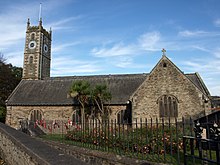Church of King Charles the Martyr, Falmouth
| Falmouth Parish Church of King Charles the Martyr | |
|---|---|

King Charles Church, Falmouth
|
|
| Coordinates: 50°09′10″N 05°04′03″W / 50.15278°N 5.06750°W | |
| Country | United Kingdom |
| Denomination | Church of England |
| Churchmanship | Broad Church |
| Website | www.kcmchurchfalmouth.org.uk |
| History | |
| Dedication | King Charles the Martyr |
| Architecture | |
| Heritage designation | Grade II* listed |
| Designated | 22 July 1949 |
| Administration | |
| Parish | Falmouth, Cornwall |
| Archdeaconry | Cornwall |
| Diocese | Truro |
| Province | Canterbury |
| Clergy | |
| Rector | Revd Stephen Tudgey |
| Laity | |
| Reader(s) | Jan Winslade |
The Church of King Charles the Martyr (Cornish: Eglos Karol Myghtern ha Merther) is a parish church in the Church of England situated in the centre of Falmouth, Cornwall.
The foundations of the church were laid by Sir Peter Killigrew on 29 August 1662. Some 18 months later, on 21 February 1664, John Bedford, the Rector of Gerrans in the Roseland, preached the first sermon at the church and on 22 August 1665 it was consecrated. John Bedford's son, Francis Bedford was then appointed the first rector by Seth Ward, Bishop of Exeter.
The Church was dedicated to King Charles the Martyr, a title of King Charles I commemorating his execution on 30 January 1649 after the English Civil War. At the end of the war his heir, later Charles II, fled into exile via Pendennis Castle, a mile or so from where the church now stands, and planned to build "a chapel for public worship ... and when the wars ceased, to send an able and conscientious chaplain to preach God's word therein". Following the Restoration of the Monarchy however, it was Sir Peter Killigrew, of the nearby Arwenack Manor, who, having a long-standing ambition to found a town and a church on the Haven, sent an emissary to the King in London in 1660, seeking the grant of a Charter for the new town of Falmouth. He also offered land for a church, parsonage and churchyard if the King would sponsor the project. Owing partly, perhaps, to his diplomatic dedication of his new church to the King's martyred father, Sir Peter succeeded in modifying the royal vow and "received much help... through the generosity of Charles II and the Duke of York, and the liberal contributions of diverse honourable and worthy persons". The new parish of Falmouth was previously part of Budock parish; the rectory (benefice) was endowed by Sir Peter with a rate on every house in the new parish. However the members of various Nonconformist sects were very unwilling to pay the rate and they were a large part of the population in the late 17th century; later rectors were "glad to make arrangements for its final extinction".
...
Wikipedia
